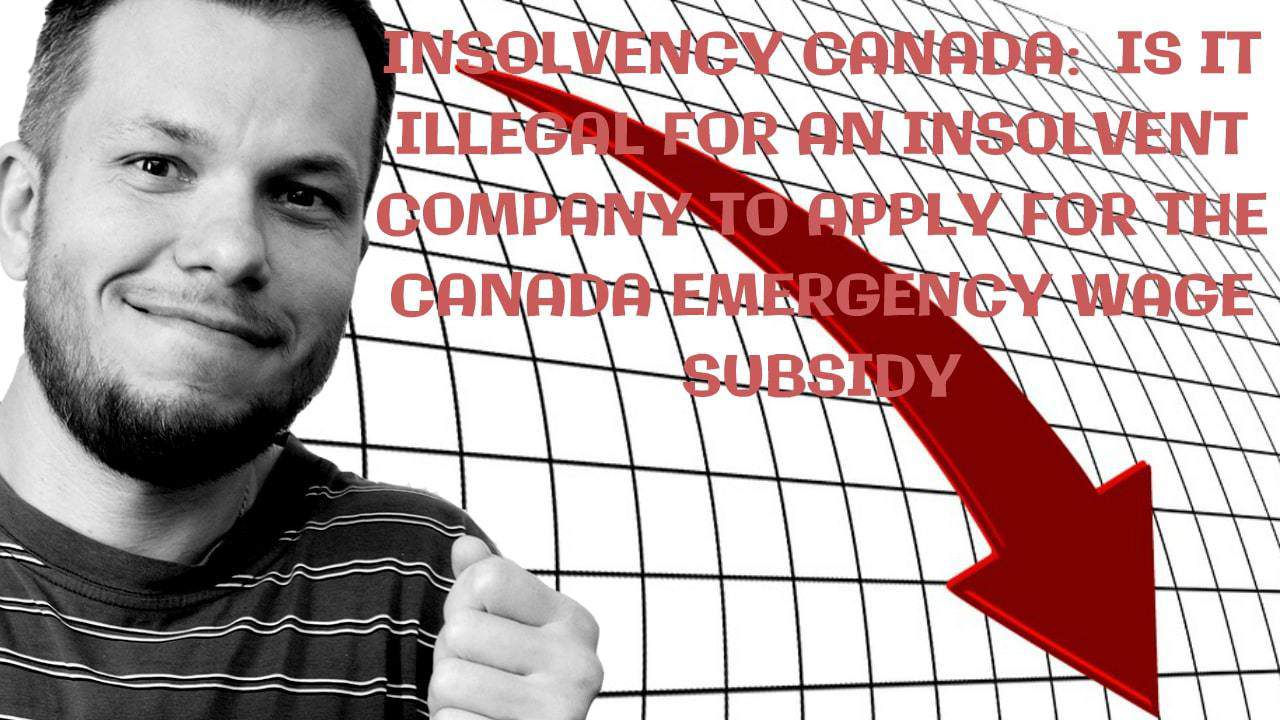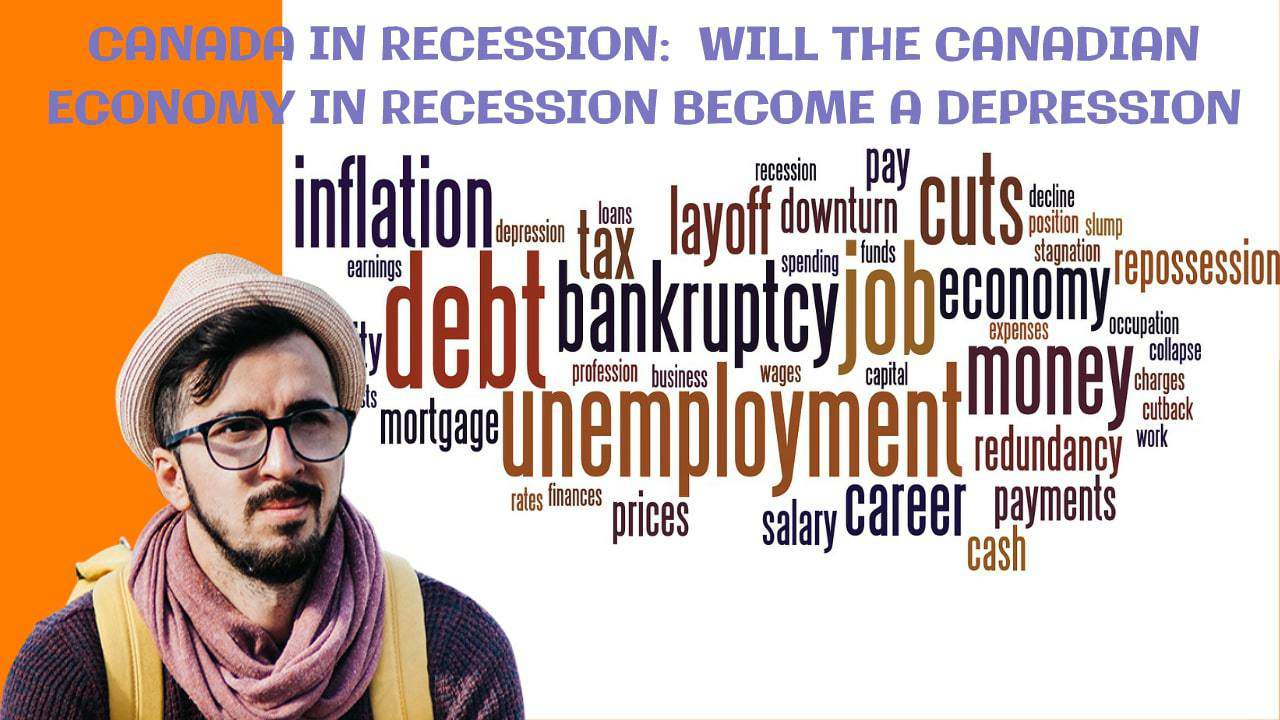The Ira Smith Trustee Team is absolutely operational and Ira, in addition to Brandon Smith, is readily available for a telephone consultation or video meeting. We hope that you and your family are safe, healthy and secure.
If you would prefer to listen to the audio version of this insolvency Canada Brandon’s Blog, please scroll to the bottom and click play on the podcast.

Insolvency Canada introduction
Canadian business restructuring, a type of insolvency Canada, has been in the news lately and no doubt will continue to be for some time. The COVID-19 pandemic, the lockdown and general fear have affected everyone; both Canadian business, employees and all other Canadians. Everyone is forecasting that business insolvencies will rise as a result of the coronavirus.
An interesting question posed to us recently is, is it illegal for an insolvency Canada company to apply for the Canada Emergency Wage Subsidy (CEWS). I have written a couple of blogs specifically on the CEWS previously:
In this Brandon’s Blog, I discuss the concept of CEWS and try to answer the question about insolvent companies applying for COVID-19 support.
Insolvency Canada CEWS refresher
The CEWS was established for an initial 12-week period from March 15 to June 6, 2020, offering a 75-per-cent wage help to qualified firms. Then on May 15, 2020, PM Justin Trudeau announced a CEWS expansion for 3 additional months to August 29. The CEWS safeguards work by assisting organizations to maintain workers on the payroll as well as also encouraging firms to re-hire staff members previously laid off. To date, 296,030 employers, representing 924,970 applications, have applied to the CEWS program.
Former Finance Minister Bill Morneau then announced in July that the CEWS extension would consist of program changes that would broaden the reach of the program. It would certainly offer much better-targeted assistance to guarantee that more workers can return to their work without delay as the economy reboots.
The modifications announced in July for the CEWS extension would:
- Prolong the program up until November 21, 2020, with the intent to provide additional support up until December 19, 2020.
- Make the aid available to a more variety of companies to include those with a revenue decline of less than 30%.
- Provide a slowly lowering base help to all eligible companies. This would assist various companies with much less than a 30% earnings loss get aid to keep employees.
- Present a top-up aid of around an added 25 percent for companies that have really been most adversely affected by the pandemic. This would be particularly practical to firms in markets that are recovering far more slowly.
- Offer assurance to firms that have really already made business decisions for July as well as August by ensuring they would not have their benefits less than they would have had under the previous CEWS program.
- Address particular issues brought to the government’s attention by various stakeholder groups.
By helping people get back to work and sustaining companies as they try to grow their income, these modifications gave companies some certainty that they needed to recall workers. It is very possible that some employers would fall into an insolvency Canada category.
Insolvency Canada: The current CEWS statistics
The Canadian government has approved 910,940 of the total applications so far. The approved applications by value are:
Under $100K 863,700
$100K to $1M 44,990
$1M to $5M 2,010
Over $5M 240
Total 940,940
To look at is it illegal for an insolvent company to apply for CEWS, we first need to see what the requirements are. Could it be that applications have been made by insolvency Canada employers? For sure it is!
Insolvency Canada: When is an employer eligible for the CEWS
The CEWS was first set up through the passage of BILL C-14, A second Act respecting certain measures in response to COVID-19. It received Royal Assent on April 11, 2020. It establishes the rules for the CEWS program, as amended and extended.
For the purposes of the wage subsidy, an eligible employer is:
- a company or a trust, besides a corporation or a trust fund that is excluded from tax obligation under Part I of the Income Tax Act or is a public institution;
- an individual aside from a trust;
- a registered charity (other than a public institution);
- a person that is exempt from tax obligation under Part I of the Income Tax Act (aside from a public institution), that is:
- a farming organization;
- a board of trade or a chamber of commerce;
- a non-profit corporation for SRED activities;
- a labour organization or society;
- a benevolent or fraternal benefit society or order; and
- a non-profit organization;
- a partnership where each member of which is an individual or partnership in this listing;
- a prescribed company, including certain Indigenous companies or businesses.
As you can see, the list is very exhaustive. The legislation does not exclude an insolvent company or mention anything about insolvency Canada. The legislation also does not exclude a company that has filed for a corporate restructuring being either a proposal under the Bankruptcy and Insolvency Act (Canada) (BIA) or under the Companies’ Creditors Arrangement Act (Canada) (CCAA).
Insolvency Canada: How does an eligible employer qualify for the wage subsidy?
In order to get the wage subsidy in respect of a specific claim period, an eligible company needed to have on March 15, 2020, an open payroll program account with the CRA and was using that account to make its payroll remittances.
Concerning the revenue test, a company’s income for the subsidy includes its revenue earned in Canada on an arm’s length basis, calculated utilizing the employer’s regular bookkeeping approach. Companies can pick to calculate their earnings using either a cash basis or the accrual technique of bookkeeping. Companies have to make use of the method they select when they first make an application for the CEWS for the duration of the program. Employers cannot combine the methods.
When a qualified employer has computed its qualifying revenue for each and every relevant claim period, it would determine if it has actually experienced the needed reduction in income to qualify for the wage subsidy for that claim period. However, the company is under no obligation to prove that the decrease in income is connected to the COVID-19 situation. If it does not qualify for one claim period, it is not barred from determining if it qualifies for any other claim period.
There is nothing in the legislation that disqualifies an insolvent company that is an eligible employer from calculating if it meets the test for eligibility for the CEWS. The phrase “insolvency Canada” does not appear anywhere.
Insolvency Canada: It is not illegal for an insolvent company to apply for the CEWS
From my research, as described above, I have not found anything in the legislation that established the CEWS that would make it illegal for an insolvency Canada employer to apply for the CEWS. If you think about it, this makes sense.
The Canadian government was worried that companies shutting down meant all workers were laid off and be applying for the Canada Emergency Response Benefit (CERB). As the economy opened up again, the government wanted to make it easier for businesses to bring back some or all of their workers in a very unsettling and uncharted time. The aim of all the Canadian government support programs is to give assistance to struggling companies.
There is an implicit assumption that companies could very well be insolvent and would therefore not be able to reopen unless they had financial support. So not only is it not illegal for an insolvent company to apply for the CEWS, it is quite logical that an insolvent company would not reopen or if it did, not hire back many workers.
This is, in my view, one of the reasons why the CEWS was established; to bring back Canadian workers to companies that could not otherwise afford to pay its employees if it could not receive back a refund for what it was spending on wages or salaries.
Insolvency Canada: How would the CEWS be treated under a formal restructuring
Whether the company is restructuring under the BIA or CCAA, the treatment of the CEWS is the same. The CEWS is taxable. You need to include the amount you get on the company’s or business’s income tax return when calculating your taxed revenue.
You will certainly likewise be expected to report the amount of the CEWS that was used to pay each of your staff members’ incomes by utilizing a unique code in the “other information” area at the end of the respective employee’s T4 slip. That specific information on the reporting needs has not yet been made public by the government. It presumably will be before the end of the year.
So in either a BIA or CCAA insolvency business restructuring, the CEWS should be shown as:
- revenue in any cash flow statement prepared with anticipated receipt dates;
- income for accounting and financial statement purposes; and
- disclosed in the Trustee’s/Monitor’s reporting to stakeholders.
If it turns out that the employer involved in a formal restructuring did not qualify for a CEWS payment for one or more of the periods that it applied and received one, then it is a liability to the government. How is that handled in the restructuring? There could be two answers. From my research, I do not see this specifically being addressed.
You may need to return all or part of the CEWS you have actually already received if you:
- send to the Canada Revenue Agency (CRA) any type of modifications to a previous application;
- terminate an application;
- made a calculation or data mistake for a claim;
- learn you do not qualify after getting a subsidy payment for a claim made; or
- receive a notice from the CRA that, following an evaluation, your claim has actually been lowered or disallowed.
Any type of CEWS overpayment you received that is not returned will be subject to interest charges. In the very next insolvency Canada section, I discuss what kind of liability a CEWS overpayment would be in a formal insolvency restructuring.
Insolvency Canada: What kind of liability is a CEWS overpayment
The CEWS is a subsidy payment made to you by CRA based on an application the insolvent company makes. Unlike a claim for unremitted source deductions or HST, it is not an amount the insolvent company collected, held in trust for and failed to remit to CRA. So as far as I am concerned, it is not a trust claim. It would be an ordinary unsecured claim.
The overpayment claim may not necessarily be caught in the restructuring. If the insolvent company applied for the CEWS AND received the subsidy payment BEFORE making the restructuring filing under either the BIA or CCAA, then I believe it would be an ordinary unsecured claim in the restructuring. However, if the company applied for the CEWS AFTER filing for restructuring, regardless of the claim period, the overpayment claim would be a post-filing claim and not caught in the restructuring. All of the overpayment would have to be repaid notwithstanding the formal restructuring.
If not repaid, presumably CRA would offset any other amount payable to the company, such as for HST input tax credits, against the CEWS overpayment liability in such an insolvency Canada situation.
Again, I caution that none of this appears in the CEWS legislation. It is my opinion based on my experience and the review of the relevant legislation.
Insolvency Canada summary
I hope you have found this Insolvency Canada CEWS Brandon’s Blog interesting and helpful. The Ira Smith Team family hopes that you and your family members are remaining secure, healthy and well-balanced. Our hearts go out to every person that has been affected either via misfortune or inconvenience.
We all must help each other to stop the spread of the coronavirus. Social distancing and self-quarantining are sacrifices that are not optional. Families are literally separated from each other. We look forward to the time when life can return to something near to typical and we can all be together once again.
Ira Smith Trustee & Receiver Inc. has constantly used clean, safe and secure ways in our professional firm and we continue to do so.
Income, revenue and cash flow shortages are critical issues facing entrepreneurs, their companies and individual Canadians. This is especially true these days.
If anyone needs our assistance for debt relief Canada COVID-19, or you just need some answers for questions that are bothering you, feel confident that Ira or Brandon can still assist you. Telephone consultations and/or virtual conferences are readily available for anyone feeling the need to discuss their personal or company situation.
The Ira Smith Trustee Team is absolutely operational and Ira, in addition to Brandon Smith, is readily available for a telephone consultation or video meeting.









